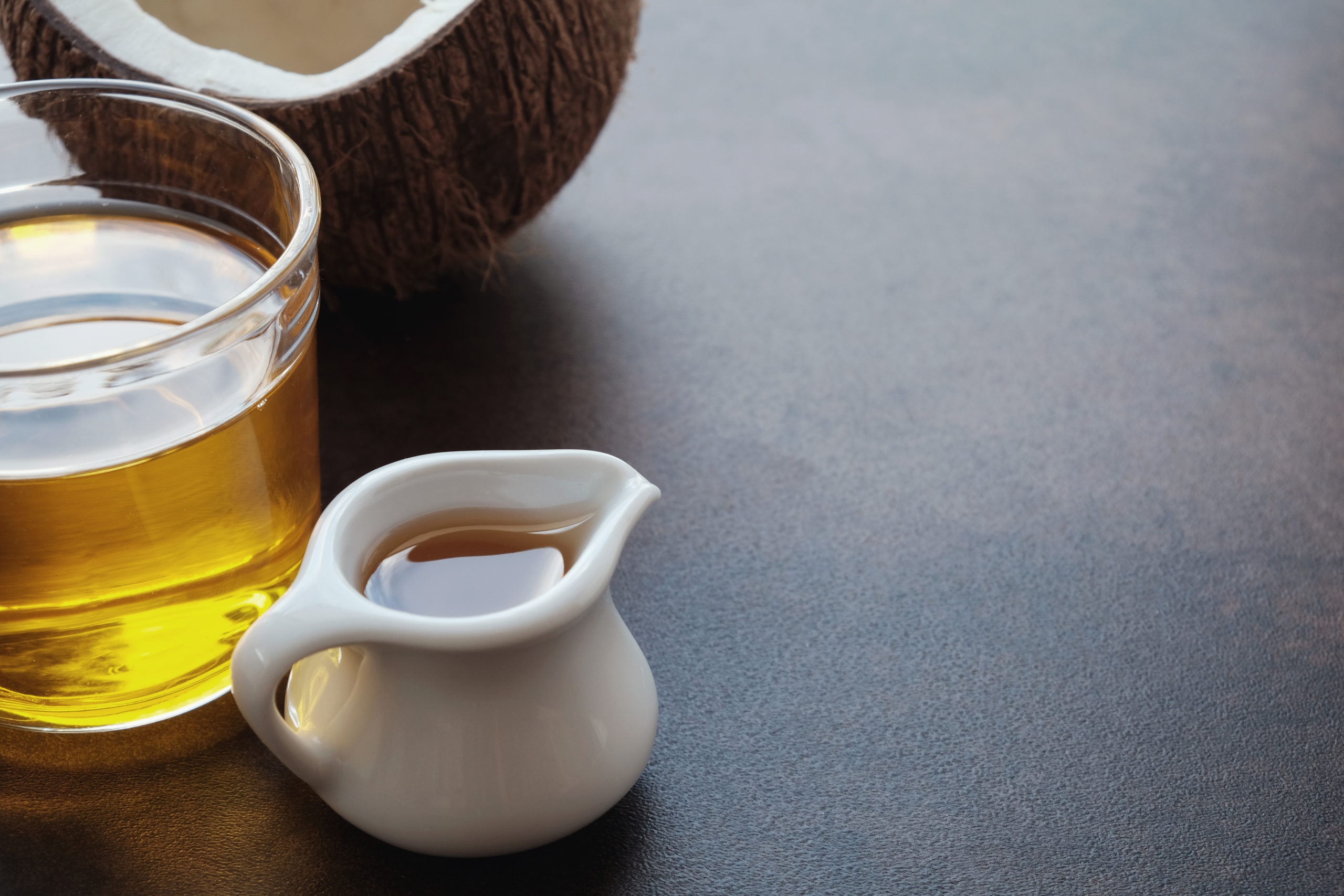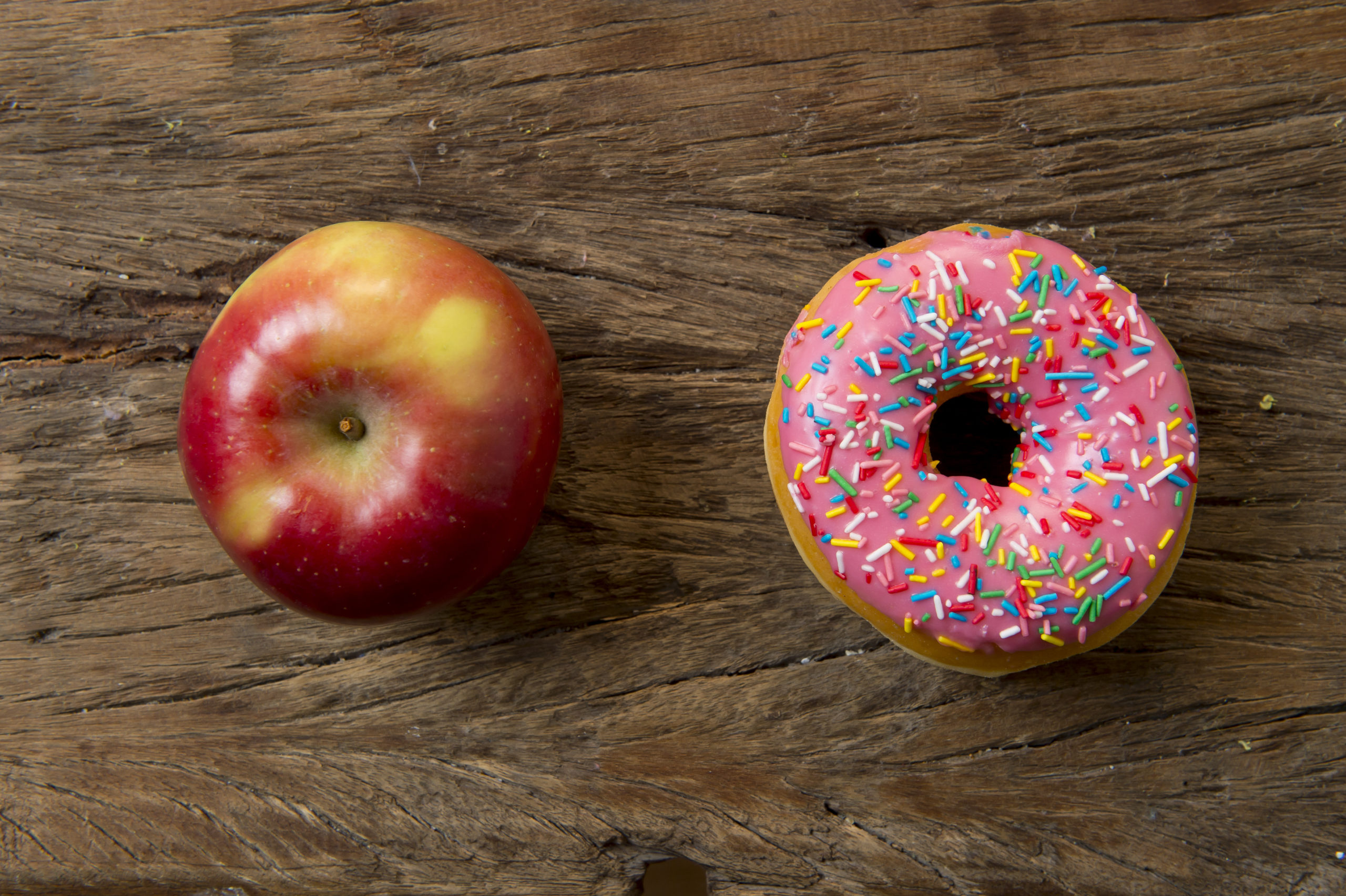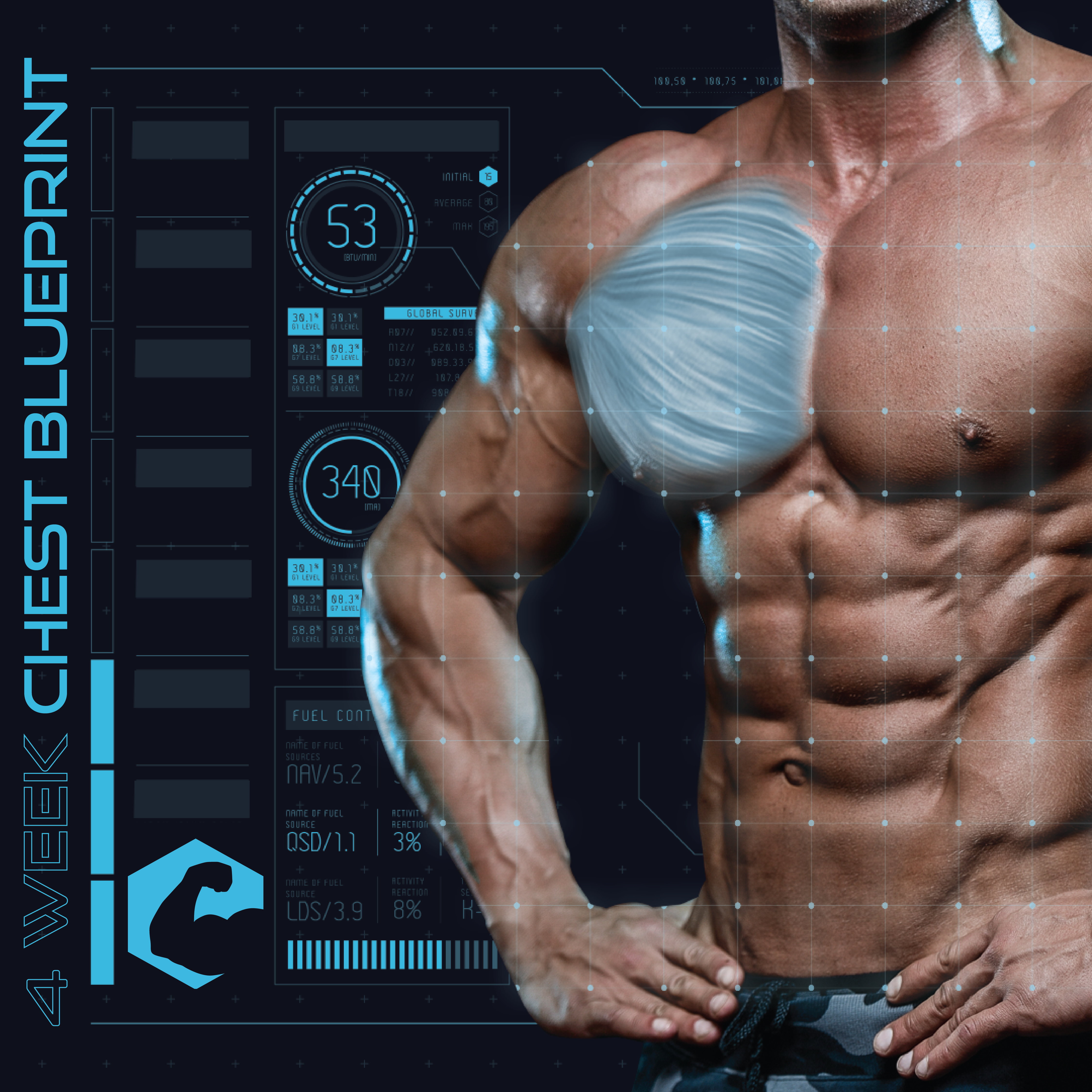Introduction
It’s finally time to discuss the age-old question, are all calories equal? And the sister inquiry, is “calories in vs. calories out” all that matters for weight loss? I think there’s been enough noise and shouting on social media over the past few years that this one definitely needs to be addressed from a scientific standpoint.
Are All Calories Equal?
I think we all generally understand that food contains calories. Calories are the energy component of food – we burn calories during daily life and exercise and we store excess calories if our activity demands do not exceed our calorie intake. If you’ve ever even considered doing a diet, tracking your intake of calories is the #1 thing people will tell you to do. And while that’s an absolute must for successful dieting, there does seem to be more than meets the eye when it comes to calories.
 First we must understand that the argument against all calories being equal is physiology-based – not just semantics. If we simply look up the definition of a calorie, then yes, every calorie is the same. A calorie is simply the amount of energy required to raise the temperature of one gram of water by one degree Celsius. And yes, all calories do that equally. However, the body does not treat all calories from food the same (12) so we must now examine this statement from a physiological perspective.
First we must understand that the argument against all calories being equal is physiology-based – not just semantics. If we simply look up the definition of a calorie, then yes, every calorie is the same. A calorie is simply the amount of energy required to raise the temperature of one gram of water by one degree Celsius. And yes, all calories do that equally. However, the body does not treat all calories from food the same (12) so we must now examine this statement from a physiological perspective.
The type of nutrients that contain calories are referred to as, “macronutrients.” This includes carbohydrates, proteins, fats, and, – ahem – alcohols. Carbs and protein both have 4-calories per gram, fat has 9-calories per gram, and alcohol has 7-calories per gram. One major difference between calories is that not all macronutrients create the same, “thermic effect” (12). The thermic effect of food refers to the fact that it requires energy to digest and absorb the nutrients from a given food source (43). Protein produces a higher thermic effect than carbohydrates which induce a higher thermic effect than fat (30,43). This means that if you ingest a high protein meal, you should burn more calories digesting and absorbing it than you would from digesting a high fat meal.
We see proof of the thermic effect when subjects consume meals or diets that are higher in protein or carbohydrate content than fat content. High protein and high carb meals result in significantly higher resting energy expenditures than high fat meals (21,22,30,31). One such study found a 39% difference in resting energy expenditure between high carb/protein meals and high fat meals (47).
So already we’re seeing that not all calories from food are equal when considering calorie balance, but there’s still more to cover. Two more major differences appear when examining macronutrient-specific calories: satiation and satiety. Satiation is the process of reducing hunger within a specific feeding – AKA you get full more quickly as you eat a big meal. Satiety, then, is how long you stay full from that specific meal (12). Studies show that protein is more satiating than carbohydrate which is more satiating than fat (2,6,15,20). Therefore, the quicker you get full from a meal and the longer you stay full, the fewer overall calories you’ll consume throughout the day. You can examine this even further by looking at specific sources of carbohydrates – fiber is more satiating than complex carbs which are more satiating than simple sugars (13,27). So now we’re not only seeing that all calories are not equal, we’re even seeing that specific types of macronutrients can influence total calorie intake throughout the day.
 Fat sources can also differ in caloric quality. Several studies have found the use of MCT oils to increase resting energy expenditure when compared to using traditional cooking oils (40,41). Some studies have even found greater overall fat and weight loss in subjects using MCT oils over traditional oils, even though diet and exercise were controlled between subject groups (41,45). Interestingly enough, some research shows that MCT oils may not have the same weight loss effects for women, so more investigations certainly need to be done in this respect (40). MCT oils have also been found to increase satiety which can lead to fewer calories eaten throughout the day (42,46).
Fat sources can also differ in caloric quality. Several studies have found the use of MCT oils to increase resting energy expenditure when compared to using traditional cooking oils (40,41). Some studies have even found greater overall fat and weight loss in subjects using MCT oils over traditional oils, even though diet and exercise were controlled between subject groups (41,45). Interestingly enough, some research shows that MCT oils may not have the same weight loss effects for women, so more investigations certainly need to be done in this respect (40). MCT oils have also been found to increase satiety which can lead to fewer calories eaten throughout the day (42,46).
Another important factor to consider when assessing calorie intake is insulin sensitivity and the Glycemic Index. Insulin is a hormone that is primarily responsible for nutrient storage – especially carbohydrate. We can store carbohydrates in our liver and muscle cells as glycogen, or if we ingest too much/exercise too little, we can store them as body fat through a process known as, “de novo lipogenesis” (36). This process can be highly mediated by insulin sensitivity. If insulin sensitivity is low (could be due to a variety of reasons), carbohydrates will preferentially be stored as fat instead of muscle glycogen (36). This is why exercising while dieting is so important – exercise can directly improve insulin sensitivity which can result in fewer carbohydrates being stored as fat (29). In addition, the impact of these factors on overall calorie balance is not well-understood, however, it’s clear that these issues could certainly direct the “quality” of weight loss/weight gain – if you can’t use carbs for energy as well, what substrate are you left with? We’ll get into that later.
The Glycemic Index is highly related to insulin in that it measures how a food impacts blood glucose levels (34). Foods that are lower on the GI will not significantly raise blood glucose and result in a lower insulin response while foods higher on the GI will result in higher blood glucose levels and corresponding insulin production (34). Carbohydrates are the most common macronutrient associated with the GI but fats and proteins can also stimulate insulin production if ingested in high quantities (25). Fast digesting proteins, such as egg or whey protein, will result in higher insulin production than slow digesting proteins (10,24). Certain dietary strategies that promote low GI foods may improve insulin sensitivity which can result in less body fat accumulation, especially in at-risk populations (32,48).
A Glycemic Index-based diet hasn’t always been found to be a great determinant to improving insulin sensitivity (19) but it has been shown that the overall glycemic load of a diet can greatly influence insulin sensitivity. The glycemic load refers to both the GI of foods that one is ingesting plus the overall amount of these foods (35). A diet high in glycemic load will often increase blood glucose levels and impair insulin sensitivity (4) – both of which are correlated to fat accumulation and weight gain (32). Ultimately, for young and healthy individuals not on a keto diet, the Glycemic Index or worries about insulin levels probably won’t be major factors in your dietary preferences. However, as you get older or start experiencing issues related with all of the above, it can certainly play a role in your overall health and body composition goals.
 One last component to consider when comparing calories to calories is the effect of exercise. Intense exercise has been shown to increase metabolism for periods up to 38-hours following exercise (37). This effect is known as, “excess post-exercise oxygen consumption,” or simply, EPOC (1,44). This period of increased oxygen utilization and higher metabolism means that ingested calories may not, “act,” as they usually would since the muscle is much more sensitive to nutrient uptake during this period. The muscle will be utilizing more amino acids from protein and overall energy at this time as protein breakdown, repair, and building are some of the processes that contribute to the burning of excess calories following exercise (5).
One last component to consider when comparing calories to calories is the effect of exercise. Intense exercise has been shown to increase metabolism for periods up to 38-hours following exercise (37). This effect is known as, “excess post-exercise oxygen consumption,” or simply, EPOC (1,44). This period of increased oxygen utilization and higher metabolism means that ingested calories may not, “act,” as they usually would since the muscle is much more sensitive to nutrient uptake during this period. The muscle will be utilizing more amino acids from protein and overall energy at this time as protein breakdown, repair, and building are some of the processes that contribute to the burning of excess calories following exercise (5).
There’s a lot of factors that go into what makes a calorie from a specific food source affect the body in different manners. While semantically, all calories are certainly equal, just keep in mind that the body does not treat all calories from food the same (12) and you’ll be fine.
Calories in vs. Calories Out (CICO)
Calories in vs. calories out is an extremely polarizing topic when it comes to dieting. There’s absolutely truth in CICO when one considers the Law of Thermodynamics. Energy balance should be achieved by either storing excess energy (too many calories in) or burning excess energy (too many calories out). But, there’s quite a few more moving parts than just food intake and exercise, so let’s get into that here.
One of the main things that immediately makes CICO a little more interesting is that men typically have a higher resting energy expenditure than women (26,28). This means that a man will burn more calories than a woman while at rest. Therefore a man and a woman could theoretically eat the same diet and perform the same exercise prescription and the man would lose more weight. And wouldn’t you know it, this theory has been tested and proven. Men consuming the same diet and undergoing the same training program lose more weight than women due to the fact that men burn more calories at rest and during exercise (7). Many metabolism calculators will account for this difference between genders but this still represents an interesting scenario when considering the component of, “calories out.”
 To further that point, several researchers have noted that the CICO argument is much too simple to completely describe or predict weight loss (8). Science shows that there’s more components to energy balance that influence CICO and that all of those factors directly influence one another (8). This is easily shown in studies that find lower resting energy expenditure levels when subjects undergo calorie-restricted diets (8,18). Therefore, if you begin a calorie-restricted diet, you actually end up burning fewer overall calories throughout the day which can defeat the purpose of the diet, especially if you’re not exercising. While this still technically aligns with CICO, your baseline calculations need to be constantly adjusted and accounted for to be as accurate as possible as your metabolism is constantly adapting to your diet.
To further that point, several researchers have noted that the CICO argument is much too simple to completely describe or predict weight loss (8). Science shows that there’s more components to energy balance that influence CICO and that all of those factors directly influence one another (8). This is easily shown in studies that find lower resting energy expenditure levels when subjects undergo calorie-restricted diets (8,18). Therefore, if you begin a calorie-restricted diet, you actually end up burning fewer overall calories throughout the day which can defeat the purpose of the diet, especially if you’re not exercising. While this still technically aligns with CICO, your baseline calculations need to be constantly adjusted and accounted for to be as accurate as possible as your metabolism is constantly adapting to your diet.
We’ve all heard the old adage, “you have to burn an extra 3500-calories to lose a pound of bodyweight.” Now, from a theoretical CICO standpoint, this could absolutely be true. However, one such study was performed where subjects were strictly controlled on both diet and exercise. The subjects completed 100 days at a 1000-calorie deficit and lost anywhere from 3-12kg over 16-weeks (3). If you do the CICO math for the study’s calculated average total of 84,369 excess calories burned, you should end up losing 24.1-lbs, or, 10.95kg (84,369 / 3500 / 2.2). The average subject lost 8kg – a 27% difference from CICO calculation. There’s several factors involved in energy balance, and a simple equation doesn’t paint the whole picture for long term weight loss.
We’ve seen this repeated in other studies where researchers predict weight gain or weight loss due to controlled caloric intake using simple CICO formulas. No surprise here, the predictions were different from the actual observed results. The researchers claimed that changes in resting energy expenditure due to weight fluctuation are more than likely liable (18). Again, there’s more to it than just simple calculations when considering long term weight loss. Ultimately, this scenario is probably too complex for novice physique competitors to be offering diet prescriptions on Instagram, but I digress…
Don’t get me wrong, at the end of the day, calories in vs. calories out is an integral component of any diet – for the most part, you pretty much have to be in a calorie deficit to lose significant weight (8,33). However, macronutrient proportions within your diet can also play a large role. While the research is often split on these differences, we do know that just about everyone will have a unique response to macronutrient modulation, so it’s important to try some trial-and-error on yourself to see what you respond best to. Why is this important?
 From a theoretical standpoint, I could ingest a diet that leaves me with a 1000-calorie deficit per day. Let’s assume the first time I tried the diet, I ate a ton of candy and drank soda (Coke, obviously) for the majority of my calories. Would I lose weight? Probably, especially if I exercised. But would it be “good” weight? Definitely not – I’d look like a skinnier Pillsbury doughboy. Now, let’s take this same calorie deficit but replace it with a healthy diet higher in protein. How would my weight loss look now? Probably more overall weight lost and a much higher quality of weight loss – meaning most of the weight would be fat mass. I might even be ready to hit a bodybuilding stage (sarcasm). Always keep quality of weight loss in mind – weight loss does not always mean fat loss.
From a theoretical standpoint, I could ingest a diet that leaves me with a 1000-calorie deficit per day. Let’s assume the first time I tried the diet, I ate a ton of candy and drank soda (Coke, obviously) for the majority of my calories. Would I lose weight? Probably, especially if I exercised. But would it be “good” weight? Definitely not – I’d look like a skinnier Pillsbury doughboy. Now, let’s take this same calorie deficit but replace it with a healthy diet higher in protein. How would my weight loss look now? Probably more overall weight lost and a much higher quality of weight loss – meaning most of the weight would be fat mass. I might even be ready to hit a bodybuilding stage (sarcasm). Always keep quality of weight loss in mind – weight loss does not always mean fat loss.
Conclusion
Ultimately, the concept of energy balance is an important aspect to learn for anyone looking for diet information. However, it’s not the end-all, be-all. There’s more than meets the eye and understanding the body’s natural compensations to varying energy intake and the quality of certain foods is necessary for fully grasping the science of weight change. A calorie is most definitely not a calorie when concerning human physiology, and CICO is much more than a simple formula, especially for individuals trying to optimize body composition. Focus your dieting on both energy balance AND food quality to get the most out of your nutrition plan.
Easter Eggs
We know this article probably has some ambiguous passages – mostly due to the tightrope walk between getting too detailed and boring vs. keeping things digestible for the layperson. That being said, let’s make a quick list of all of the things that can influence energy balance that simple CICO calculators typically do not account for – AKA, things besides gender, NEAT, age, and body weight. Remember, virtually no study has ever perfectly predicted weight loss from a simple CICO formula, and some of these reasons can play a role.
- Macronutrient composition of your diet – we touched on this above.
- Exercise – we also touched on this above.
- Diet quality – processed foods induce a lower thermogenic effect than whole foods (read here). This would reduce your “calories out” when concerning diet-induced thermogenesis.
- Thyroid function and hormones associated with any thyroid changes (read here). This would influence “calories out” in a variety of ways depending on what exactly is going on.
- Poor sleep can reduce metabolic rate, which would reduce “calories out” (read here).
- Low calorie diets and losing body weight can also reduce metabolic rate – we touched on this some above but it’s an important reminder that your CICO formula would have to be constantly adjusted in order to keep up with these changes.
- Being sick can also increase energy expenditure (read here). This is why it’s important to maintain food intake during periods of illness so you don’t lose unwarranted weight or lean mass.
- Acute stress can actually increase metabolic rate whereas chronic stress can decrease metabolic rate (read here). These fluctuations are due to both hormonal impacts and stress-related eating habits.
- Body composition can also influence metabolic rate, AKA, “calories out” (read here). The more muscle mass you have, the higher your metabolic rate will be – especially during exercise. In addition, too much body fat can inhibit signals from the appetite-controlling hormone, leptin, which can easily lead to overeating.
- In case you haven’t caught on, just about anything can influence energy balance. While this list made seem like an overcomplication of the entire situation, it’s always worth understanding that energy balance is dynamic and ever-changing. Relying on simple math can certainly help diet plans, but understand that it’s likely never going to be perfectly accurate.
References
- American College of Sports Medicine. (2012). ACSM’s resource manual for guidelines for exercise testing and prescription. Lippincott Williams & Wilkins. Philadelphia, PA.
- Blundell, J. E., & MacDiarmid, J. I. (1997). Fat as a risk factor for overconsumption: satiation, satiety, and patterns of eating. Journal of the American Dietetic Association, 97(7), S63-S69.
- Bouchard, C., et. al. (1990). Long-term exercise training with constant energy intake. 1: Effect on body composition and selected metabolic variables. International Journal of Obesity, 14(1), 57-73.
- Brand-Miller, J. C., Thomas, M., Swan, V., Ahmad, Z. I., Petocz, P., & Colagiuri, S. (2003). Physiological validation of the concept of glycemic load in lean young adults. The Journal of Nutrition, 133(9), 2728-2732.
- Clarkson, P. M., & Sayers, S. P. (1999). Etiology of exercise-induced muscle damage. Canadian Journal of Applied Physiology, 24(3), 234-248.
- de Castro, J. M. (1999). What are the major correlates of macronutrient selection in Western populations? Proceedings of the Nutrition Society, 58(4), 755-763.
- Donnelly, J. E., et. al. (2003). Effects of a 16-month randomized controlled exercise trial on body weight and composition in young, overweight men and women: the Midwest Exercise Trial. Archives of Internal Medicine, 163(11), 1343-1350.
- Donnelly, J. E., & Smith, B. K. (2005). Is exercise effective for weight loss with ad libitum diet? Energy balance, compensation, and gender differences. Exercise and Sport Sciences Reviews, 33(4), 169-174.
- Gale, E. A., & Gillespie, K. M. (2001). Diabetes and gender. Diabetologia, 44(1), 3-15.
- Gannon, M. C., Nuttall, F. Q., Neil, B. J., & Westphal, S. A. (1988). The insulin and glucose responses to meals of glucose plus various proteins in type II diabetic subjects. Metabolism-Clinical and Experimental, 37(11), 1081-1088.
- Geer, E. B., & Shen, W. (2009). Gender differences in insulin resistance, body composition, and energy balance. Gender Medicine, 6, 60-75.
- Gerstein, D. E., Woodward-Lopez, G., Evans, A. E., Kelsey, K., & Drewnowski, A. (2004). Clarifying concepts about macronutrients’ effects on satiation and satiety. Journal of the American Dietetic Association, 104(7), 1151-1153.
- Howarth, N. C., Saltzman, E., & Roberts, S. B. (2001). Dietary fiber and weight regulation. Nutrition Reviews, 59(5), 129-139.
- Johnstone, A. M., Murison, S. D., Duncan, J. S., Rance, K. A., & Speakman, J. R. (2005). Factors influencing variation in basal metabolic rate include fat-free mass, fat mass, age, and circulating thyroxine but not sex, circulating leptin, or triiodothyronine–. The American Journal of Clinical Nutrition, 82(5), 941-948.
- Johnstone, A. M., Stubbs, R. J., & Harbron, C. G. (1996). Effect of overfeeding macronutrients on day-to-day food intake in man. European Journal of Clinical Nutrition, 50(7), 418-430.
- Karst, H., Steiniger, J., Noack, R., & Steglich, H. D. (1984). Diet-induced thermogenesis in man: thermic effects of single proteins, carbohydrates and fats depending on their energy amount. Annals of Nutrition and Metabolism, 28(4), 245-252.
- Lean, M. E., & James, W. P. (1988). Metabolic effects of isoenergetic nutrient exchange over 24 hours in relation to obesity in women. International Journal of Obesity, 12(1), 15-27.
- Leibel, R. L., Rosenbaum, M., & Hirsch, J. (1995). Changes in energy expenditure resulting from altered body weight. New England Journal of Medicine, 332(10), 621-628.
- Liese, A. D., Schulz, M., Fang, F., Wolever, T. M., D’Agostino, R. B., Sparks, K. C., & Mayer-Davis, E. J. (2005). Dietary glycemic index and glycemic load, carbohydrate and fiber intake, and measures of insulin sensitivity, secretion, and adiposity in the Insulin Resistance Atherosclerosis Study. Diabetes care, 28(12), 2832-2838.
- Marmonier, C., Chapelot, D., & Louis-Sylvestre, J. (2000). Effects of macronutrient content and energy density of snacks consumed in a satiety state on the onset of the next meal. Appetite, 34(2), 161-168.
- Nair, K. S., Halliday, D., & Garrow, J. S. (1983). Thermic response to isoenergetic protein, carbohydrate or fat meals in lean and obese subjects. Clinical Science, 65(3), 307-312.
- Nguo, K., Huggins, C. E., Truby, H., Brown, J., & Bonham, M. P. (2018). Effect of macronutrient composition on meal-induced thermogenesis in adolescents with obesity. European Journal of Nutrition, 1-7.
- Nordmann, A. J., Nordmann, A., Briel, M., Keller, U., Yancy, W. S., Brehm, B. J., & Bucher, H. C. (2006). Effects of low-carbohydrate vs low-fat diets on weight loss and cardiovascular risk factors: a meta-analysis of randomized controlled trials. Archives of Internal Medicine, 166(3), 285-293.
- Nuttall, F. Q., & Gannon, M. C. (1990). Metabolic response to egg white and cottage cheese protein in normal subjects. Metabolism-Clinical and Experimental, 39(7), 749-755.
- Nuttall, F. Q., Mooradian, A. D., Gannon, M. C., Billington, C., & Krezowski, P. (1984). Effect of protein ingestion on the glucose and insulin response to a standardized oral glucose load. Diabetes Care, 7(5), 465-470.
- Paul, D. R., Novotny, J. A., & Rumpler, W. V. (2004). Effects of the interaction of sex and food intake on the relation between energy expenditure and body composition. The American Journal of Clinical Nutrition, 79(3), 385-389.
- Pereira, M. A., & Ludwig, D. S. (2001). Dietary fiber and body-weight regulation: observations and mechanisms. Pediatric Clinics of North America, 48(4), 969-980.
- Perseghin, G., et. al. (2001). Gender factors affect fatty acids-induced insulin resistance in nonobese humans: effects of oral steroidal contraception. The Journal of Clinical Endocrinology & Metabolism, 86(7), 3188-3196.
- Poehlman, E. T., Dvorak, R. V., DeNino, W. F., Brochu, M., & Ades, P. A. (2000). Effects of resistance training and endurance training on insulin sensitivity in nonobese, young women: a controlled randomized trial. The Journal of Clinical Endocrinology & Metabolism, 85(7), 2463-2468.
- Quatela, A., Callister, R., Patterson, A., & MacDonald-Wicks, L. (2016). The energy content and composition of meals consumed after an overnight fast and their effects on diet induced thermogenesis: a systematic review, meta-analyses and meta-regressions. Nutrients, 8(11), 670.
- Raben, A., Agerholm-Larsen, L., Flint, A., Holst, J. J., & Astrup, A. (2003). Meals with similar energy densities but rich in protein, fat, carbohydrate, or alcohol have different effects on energy expenditure and substrate metabolism but not on appetite and energy intake. The American Journal of Clinical Nutrition, 77(1), 91-100.
- Reinehr, T., Kiess, W., Kapellen, T., & Andler, W. (2004). Insulin sensitivity among obese children and adolescents, according to degree of weight loss. Pediatrics, 114(6), 1569-1573.
- Sacks, F. M., et. al. (2009). Comparison of weight-loss diets with different compositions of fat, protein, and carbohydrates. New England Journal of Medicine, 360(9), 859-873.
- Sacks, F. M., et. al. (2014). Effects of high vs low glycemic index of dietary carbohydrate on cardiovascular disease risk factors and insulin sensitivity: the OmniCarb randomized clinical trial. Jama, 312(23), 2531-2541.
- Salmeron, J., Manson, J. E., Stampfer, M. J., Colditz, G. A., Wing, A. L., & Willett, W. C. (1997). Dietary fiber, glycemic load, and risk of non—insulin-dependent diabetes mellitus in women. Jama, 277(6), 472-477.
- Saltiel, A. R., & Kahn, C. R. (2001). Insulin signalling and the regulation of glucose and lipid metabolism. Nature, 414(6865), 799.
- Schuenke, M. D., Mikat, R. P., & McBride, J. M. (2002). Effect of an acute period of resistance exercise on excess post-exercise oxygen consumption: implications for body mass management. European Journal of Applied Physiology, 86(5), 411-417.
- Schwartz, R. S., Ravussin, E., Massari, M., O’Connell, M., & Robbins, D. C. (1985). The thermic effect of carbohydrate versus fat feeding in man. Metabolism-Clinical and Experimental, 34(3), 285-293.
- Shai, I., et. al. (2008). Weight loss with a low-carbohydrate, Mediterranean, or low-fat diet. New England Journal of Medicine, 359(3), 229-241.
- St-Onge, M. P., Bourque, C., Jones, P. J. H., Ross, R., & Parsons, W. E. (2003). Medium-versus long-chain triglycerides for 27 days increases fat oxidation and energy expenditure without resulting in changes in body composition in overweight women. International Journal of Obesity, 27(1), 95.
- St‐Onge, M. P., Ross, R., Parsons, W. D., & Jones, P. J. (2003). Medium‐chain triglycerides increase energy expenditure and decrease adiposity in overweight men. Obesity Research, 11(3), 395-402.
- Stubbs, R. J., & Harbron, C. G. (1996). Covert manipulation of the ratio of medium-to long-chain triglycerides in isoenergetically dense diets: effect on food intake in ad libitum feeding men. International journal of obesity and related metabolic disorders: Journal of the International Association for the Study of Obesity, 20(5), 435-444.
- Tappy, L. (1996). Thermic effect of food and sympathetic nervous system activity in humans. Reproduction Nutrition Development, 36(4), 391-397.
- Thornton, M. K., & Potteiger, J. A. (2002). Effects of resistance exercise bouts of different intensities but equal work on EPOC. Medicine and Science in Sports and Exercise, 34(4), 715-722.
- Tsuji, H., Kasai, M., Takeuchi, H., Nakamura, M., Okazaki, M., & Kondo, K. (2001). Dietary medium-chain triacylglycerols suppress accumulation of body fat in a double-blind, controlled trial in healthy men and women. The Journal of Nutrition, 131(11), 2853-2859.
- Van Wymelbeke, V., Himaya, A., Louis-Sylvestre, J., & Fantino, M. (1998). Influence of medium-chain and long-chain triacylglycerols on the control of food intake in men. The American Journal of Clinical Nutrition, 68(2), 226-234.
- Westerterp, K. R., Wilson, S. A. J., & Rolland, V. (1999). Diet induced thermogenesis measured over 24h in a respiration chamber: effect of diet composition. International Journal of Obesity, 23(3), 287-292.
- Wolever, T. M., Jenkins, D. J., Jenkins, A. L., & Josse, R. G. (1991). The glycemic index: methodology and clinical implications. The American Journal of Clinical Nutrition, 54(5), 846-854.
From being a mediocre athlete, to professional powerlifter and strength coach, and now to researcher and writer, Charlie combines education and experience in the effort to help Bridge the Gap Between Science and Application. Charlie performs double duty by being the Content Manager for The Muscle PhD as well as the Director of Human Performance at the Applied Science and Performance Institute in Tampa, FL. To appease the nerds, Charlie is a PhD candidate in Human Performance with a master’s degree in Kinesiology and a bachelor’s degree in Exercise Science. For more alphabet soup, Charlie is also a Certified Strength and Conditioning Specialist (CSCS), an ACSM-certified Exercise Physiologist (ACSM-EP), and a USA Weightlifting-certified performance coach (USAW).




